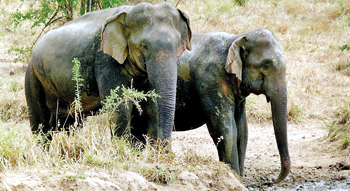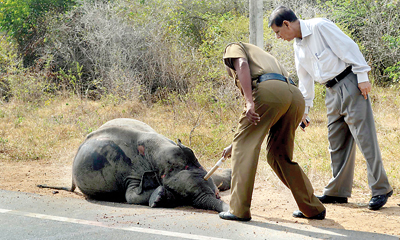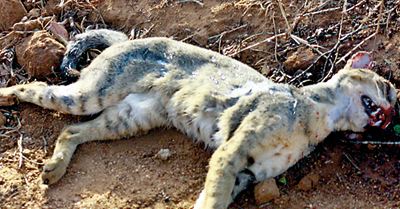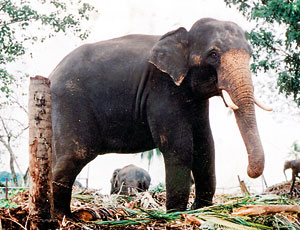Life and colour in a park gone dry
By Srilal MiththapalaView(s):A recent visit to the popular Uda Walawe National Park (UWNP) saw the park quite dry, with the beginning of the long drought period. Most of the smaller water holes were bone dry, and animals were scarce and not so easy to spot. The park has many large water holes or tanks ( wewas) which is why it boasts possibly of a total population of some 700 or more elephants ( on-going research of Dr. Shermin de Silva)
We came across a small star tortoise (Geocheloneelegans) , a greatly sought after but protected animal, slowy crossing the main road and after asking the tracker to stop the jeep, we gently carried the small fellow to the side, into the grass, lest he be accidentally run over by a careless driver.
While driving along the main road my son Dimitri spotted two elephants near the thekkewewe( the teak forest water hole) and we quickly backtracked there. And weren’t we lucky. There were two males, one more senior and a younger companion, who had come down to the water. For the next half hour we watched the two majestic animals drinking, spraying themselves with water and mud bathing. They were well aware of our presence but were quite relaxed.

Eventually we arrived at the Seenuggala bungalow where we were booked to stay the night. Although the facilities are pretty basic, the food tastes better, the stars at night seem brighter, the earthy smelling air more invigorating, and above all the silence…punctuated only by the sounds of the jungle…it is very difficult to articulate these feelings in words.
Most of the bungalows overlook a large water hole, tank or wewa, and to sit outside and watch the bird life and other smaller animals is just bliss. Often if one is lucky, you can have a grandstand view of a herd of elephant come down to water on the opposite bank. A few months ago when we were here at Seenuggala, one bull decided to come visit us, and we awoke at 6 a.m. to be greeted by this massive bull elephant looking at us amusedly, just a few metres away from the verandah.
All the bungalows have their own semi- tame animals who have got accustomed to visitors somewhat. Once upon a time there was “Seenuggalaya” a massive bull elephant who frequented this bungalow to pick up tit bits. Thimbiriyamankada, another bungalow in the park, has “Edward”, the resident wild boar. …and this time we found that our friend “Timothy”, the giant squirrel at Seenuggala, had become much more bold now, checking out even the dining table.
The area around the bungalow is teeming with insects, dragonflies, butterflies and birds and is a photographer’s dream. You don’t need hides or watch towers….you just need to perch on a bough and have adequate patience, and you will be richly rewarded.
Water and fish equals kingfishers…so Seenuggala bungalow has many kingfishers that more than adequately satisfy their appetite right throughout the day. Sri Lanka has seven species of kingfishers, four of which can be seen in the Seenuggalawewe. A White-breasted Kingfisher (Halcyon smyrnensis) and the more elusive and more agile Common Kingfisher (Alcedoatthis) were around, the latter more difficult to photograph. It is one of the smaller kingfisher species and its name ‘common’ is really a misnomer because in reality it is not at all common.
Wild flowers are in no short supply at UWNP with the purple ‘wara’ (Calotropisgiantea ) being very common all over the park. It is a shrub which sprouts clusters of waxy flowers that are either white or lavender. The milky juice extracted from this plant is used as a remedy for Leprosy.
UWNP is also abundant with raptors or birds of prey. On one of our game drives we came across this magnificent specimen of a Grey-headed Fish Eagle (Ichthyophagaichthyaetus) or tank eagle perched on a low branch, which enabled us to watch him for quite a while at relatively close quarters. These are very large raptors that can attack a hare or other smaller mammals and carry them off, aided by their massive 1.5-2.0 m wing span.
On another game drive we saw this big bull elephant sand bathing to keep himself cool. He seemed to be at the tail-end of Musth as was evident from the stain on his face between the ear and eye. Musth is a periodic or seasonal condition in bull elephants, characterized by highly aggressive behaviour, accompanied by a large rise in reproductive hormones – testosterone levels which can be as much as 60 -100 times higher than normal. During this time they secrete a strong pungent smelling viscous liquid form their temporal glands
At Godawiddagala we saw a big herd of elephants in a mighty hurry to get across the river on to the other side. There was a lot of splashing, pushing and shoving and trumpeting.
On our final drive, returning to the bungalow in the fading light of the evening, we came across a large herd who had just finished watering at our Seenuggalawewa and were now crossing the road. (The darker water stain on their lower legs indicated that they had recently watered) .This particular Mother and calf seem to be quite calm as we passed very close to them.
(The writer is a wildlife enthusiast and author of the book “Tranquil Footsteps” a story about the elephants of the Uda Walawe
National Park.)


















